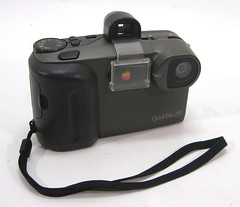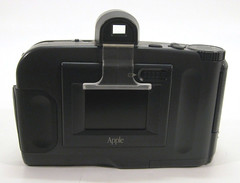Difference between revisions of "Apple"
m (→Quicktake 200 (c.Feb 1997): pics CP ->CW pool) |
(standard image templates; layout simplified, JPEG made uppercase) |
||
| Line 1: | Line 1: | ||
{{stub}} | {{stub}} | ||
| − | '''Apple Computer''' produced some of the first consumer digital cameras. | + | |
| − | The '''Quicktake''' cameras had a [[resolution]] of 640x480 [[pixel]]s (i.e. [[VGA]] computer screen size), with a colour depth of 24 bits They were designed to connect to an Apple Macintosh computer via a V.24 serial cable (which is no longer supported by OS | + | |
| + | '''Apple Computer''' produced some of the first consumer digital cameras. The '''Quicktake''' cameras had a [[resolution]] of 640x480 [[pixel]]s (i.e. [[VGA]] computer screen size), with a colour depth of 24 bits. They were designed to connect to an Apple Macintosh computer via a V.24 serial cable (which is no longer supported by OS X, or on current Mac hardware). | ||
The Quicktake cameras did not sell well, and were discontinued late in 1997. | The Quicktake cameras did not sell well, and were discontinued late in 1997. | ||
| + | __TOC__ | ||
| + | |||
| − | == | + | == Apple Digital Cameras == |
=== Quicktake 100 (Feb 1994) === | === Quicktake 100 (Feb 1994) === | ||
| − | + | ||
| − | + | {{Flickr_image | |
| − | |||
|image_source= http://www.flickr.com/photos/jaqian/329044100/in/pool-camerapedia | |image_source= http://www.flickr.com/photos/jaqian/329044100/in/pool-camerapedia | ||
|image= http://farm1.static.flickr.com/136/329044100_fd6d6f8d6c_m.jpg | |image= http://farm1.static.flickr.com/136/329044100_fd6d6f8d6c_m.jpg | ||
| − | |image_align= | + | |image_align= left |
|image_text= front | |image_text= front | ||
| + | |image_by=jaqian | ||
| + | |image_rights=cc | ||
}} | }} | ||
| − | + | {{Flickr_image | |
|image_source= http://www.flickr.com/photos/jaqian/329046230/in/pool-camerapedia | |image_source= http://www.flickr.com/photos/jaqian/329046230/in/pool-camerapedia | ||
|image= http://farm1.static.flickr.com/131/329046230_bf473d9d1c_m.jpg | |image= http://farm1.static.flickr.com/131/329046230_bf473d9d1c_m.jpg | ||
| − | |image_align= | + | |image_align= left |
|image_text=viewfinder and LCD panel | |image_text=viewfinder and LCD panel | ||
| + | |image_by=jaqian | ||
| + | |image_rights=cc | ||
}} | }} | ||
| − | + | {{Flickr_image | |
|image_source= http://www.flickr.com/photos/heritagefutures/2980707085/in/pool-camerawiki | |image_source= http://www.flickr.com/photos/heritagefutures/2980707085/in/pool-camerawiki | ||
|image= http://farm4.static.flickr.com/3008/2980707085_c08b9a5916_m.jpg | |image= http://farm4.static.flickr.com/3008/2980707085_c08b9a5916_m.jpg | ||
| − | |image_align= | + | |image_align= left |
|image_text=side, with serial socket | |image_text=side, with serial socket | ||
| + | |image_by=Dirk HR Spennemann | ||
| + | |image_rights=wp | ||
}} | }} | ||
| − | + | {{Flickr_image | |
|image_source= http://www.flickr.com/photos/heritagefutures/2981561942/in/pool-camerawiki/ | |image_source= http://www.flickr.com/photos/heritagefutures/2981561942/in/pool-camerawiki/ | ||
|image= http://farm4.static.flickr.com/3143/2981561942_a50a19a192_m.jpg | |image= http://farm4.static.flickr.com/3143/2981561942_a50a19a192_m.jpg | ||
| − | |image_align= | + | |image_align= left |
|image_text=lens cover closed | |image_text=lens cover closed | ||
| + | |image_by=Dirk HR Spennemann | ||
| + | |image_rights=wp | ||
}} | }} | ||
| − | + | ||
| − | + | {{brl}} | |
| − | |||
| − | |||
The binocular-format '''Quicktake 100''' was introduced in 1994. It had an optical viewfinder, and no viewing screen, but there was an [[LCD]] screen showing the frame number and other info. There were controls for shutter-release, flash, [[self-timer]], resolution and a recessed "Trash" ("erase whole camera") button. It had only internal [[flash memory]] - with no slots for extension, providing enough storage for a mere eight photos at full [[VGA]] 640x480 resolution, or 32 at 320x240. Images were stored in Apple's own QuickTake or PICT formats. | The binocular-format '''Quicktake 100''' was introduced in 1994. It had an optical viewfinder, and no viewing screen, but there was an [[LCD]] screen showing the frame number and other info. There were controls for shutter-release, flash, [[self-timer]], resolution and a recessed "Trash" ("erase whole camera") button. It had only internal [[flash memory]] - with no slots for extension, providing enough storage for a mere eight photos at full [[VGA]] 640x480 resolution, or 32 at 320x240. Images were stored in Apple's own QuickTake or PICT formats. | ||
=== Quicktake 150 (May 1995) === | === Quicktake 150 (May 1995) === | ||
| − | The '''Quicktake 150''' was very similar to the 100, but added the more standard [[ | + | The '''Quicktake 150''' was very similar to the 100, but added the more standard [[JPEG]], BMP, [[TIFF]] and PCX file formats. |
{{Flickr_image | {{Flickr_image | ||
| Line 51: | Line 59: | ||
|image_rights= with permission | |image_rights= with permission | ||
}} | }} | ||
| − | {{ | + | {{Flickr_image |
| + | |image_source= http://www.flickr.com/photos/moparx/3929600114/in/pool-camerawiki | ||
| + | |image= http://farm3.static.flickr.com/2468/3929600114_0410181a4a_m.jpg | ||
| + | |image_align= left | ||
| + | |image_text= Lens cover closed | ||
| + | |image_by= moparx | ||
| + | |image_rights= cc | ||
| + | }} | ||
| + | |||
| + | {{brl}} | ||
===Quicktake 200 (c.Feb 1997)=== | ===Quicktake 200 (c.Feb 1997)=== | ||
| − | The '''Quicktake 200''' was a more conventionally-shaped camera, to current eyes, having a compact-camera outline, a 1.8-inch [[LCD]] viewing screen on the back, a mode dial and a [[SmartMedia]] memory card slot (along with 2Mb of internal memory). There was no built-in optical viewfinder, but there was a clip-on accessory optical finder. The 200 was made in Japan by [[Fuji]] - as a rebadged '''[[Fujifilm DS-7|Fuji DS-7]]'''<ref>See [http://www.epi-centre.com/reports/9708bcs.html John Henshall article]</ref> - and also sold as the '''Samsung Kenox SSC-350N''' - however, the Fuji and Samsung had the added advantage of coming with software for connection to a PC as well as a Macintosh<ref>[http://www.andybaird.com/qt200/miscellany.html Andy Baird's Miscellany]</ref>. The [[resolution]] was still 640x480, but the 200 could use [[TIFF]], BMP, PCX, [[ | + | The '''Quicktake 200''' was a more conventionally-shaped camera, to current eyes, having a compact-camera outline, a 1.8-inch [[LCD]] viewing screen on the back, a mode dial and a [[SmartMedia]] memory card slot (along with 2Mb of internal memory). There was no built-in optical viewfinder, but there was a clip-on accessory optical finder. The 200 was made in Japan by [[Fuji]] - as a rebadged '''[[Fujifilm DS-7|Fuji DS-7]]'''<ref>See [http://www.epi-centre.com/reports/9708bcs.html John Henshall article]</ref> - and also sold as the '''Samsung Kenox SSC-350N''' - however, the Fuji and Samsung had the added advantage of coming with software for connection to a PC as well as a Macintosh<ref>[http://www.andybaird.com/qt200/miscellany.html Andy Baird's Miscellany]</ref>. The [[resolution]] was still 640x480, but the 200 could use [[TIFF]], BMP, PCX, [[JPEG]] and QuickTake file formats, and had an NTSC video output. It was powered by four AA batteries. |
{| | {| | ||
|- | |- | ||
| Line 76: | Line 93: | ||
}} | }} | ||
|-align="center" | |-align="center" | ||
| − | |colspan="3"|Quicktake 200 - with clip-on optical viewfinder<br><small>photos by [http://stores.ebay.com/The-Collector-Detector Dawn Laciak] | + | |colspan="3"|Quicktake 200 - with clip-on optical viewfinder<br><small>photos by [http://stores.ebay.com/The-Collector-Detector Dawn Laciak]</small> {{with permission}} |
|} | |} | ||
<references /> | <references /> | ||
Revision as of 15:09, 13 August 2011
Apple Computer produced some of the first consumer digital cameras. The Quicktake cameras had a resolution of 640x480 pixels (i.e. VGA computer screen size), with a colour depth of 24 bits. They were designed to connect to an Apple Macintosh computer via a V.24 serial cable (which is no longer supported by OS X, or on current Mac hardware).
The Quicktake cameras did not sell well, and were discontinued late in 1997.
Contents
Apple Digital Cameras
Quicktake 100 (Feb 1994)

|
| front image by jaqian (Image rights) |
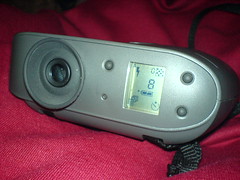
|
| viewfinder and LCD panel image by jaqian (Image rights) |
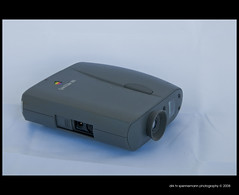
|
| side, with serial socket image by Dirk HR Spennemann (Image rights) |
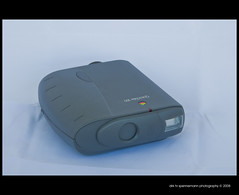
|
| lens cover closed image by Dirk HR Spennemann (Image rights) |
The binocular-format Quicktake 100 was introduced in 1994. It had an optical viewfinder, and no viewing screen, but there was an LCD screen showing the frame number and other info. There were controls for shutter-release, flash, self-timer, resolution and a recessed "Trash" ("erase whole camera") button. It had only internal flash memory - with no slots for extension, providing enough storage for a mere eight photos at full VGA 640x480 resolution, or 32 at 320x240. Images were stored in Apple's own QuickTake or PICT formats.
Quicktake 150 (May 1995)
The Quicktake 150 was very similar to the 100, but added the more standard JPEG, BMP, TIFF and PCX file formats.

|
| Apple QuickTake 150 image by Damian Ward (Image rights) |
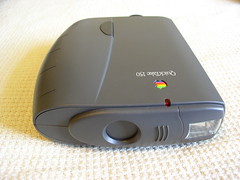
|
| Lens cover closed image by moparx (Image rights) |
Quicktake 200 (c.Feb 1997)
The Quicktake 200 was a more conventionally-shaped camera, to current eyes, having a compact-camera outline, a 1.8-inch LCD viewing screen on the back, a mode dial and a SmartMedia memory card slot (along with 2Mb of internal memory). There was no built-in optical viewfinder, but there was a clip-on accessory optical finder. The 200 was made in Japan by Fuji - as a rebadged Fuji DS-7[1] - and also sold as the Samsung Kenox SSC-350N - however, the Fuji and Samsung had the added advantage of coming with software for connection to a PC as well as a Macintosh[2]. The resolution was still 640x480, but the 200 could use TIFF, BMP, PCX, JPEG and QuickTake file formats, and had an NTSC video output. It was powered by four AA batteries.
|
|
| ||||||
| Quicktake 200 - with clip-on optical viewfinder photos by Dawn Laciak (Image rights) | ||||||||
Links/Sources
- Quicktake camera manuals at Apple.com
- Quicktake 150 at Sylvain Halgand's www.collection-appareils.fr
- Apple Quicktake 100 by John Henshall
- Apple Quicktake 200 & Fuji DS-7 by John Henshall
- Andy Baird's tips for Quicktake 200/Fuji DS-7/Samsung Kenox owners
